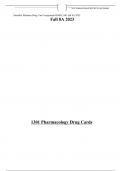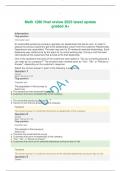Prof. Katherine Daniels MSN RN 1st day Handout
Jenniffer Medrano Drug Card Assignment RNSG 1301 fall 8A 2023
Fall 8A 2023
1301 Pharmacology Drug Cards
, Prof. Katherine Daniels MSN RN 1st day Handout
Drug: Penicillin G&V General Classification: _Penicillins/ Beta-lactam antibacterial
Prototype Ampicillin (Principen)
Pharmacokinetics After absorption is widely distributed. Penetration into the CSF occurs
only
w inflamed meninges. Kidneys rapidly excrete ampicillin, produces high
drug concentration in the urine. It is present in breast milk, and the volume
of distribution increases during pregnancy, when the half-life, generally 1-
2hrs is decreased.
Mode of Action (list 3-4 main ones) Inhibits bacterial cell wall synthesis by binding to one or multiple
penicillin-binding proteins.
Indications/Uses Bacterial infection caused by susceptible microorganisms,
prophylaxis/treatment of ineffective endocarditis, skin/soft
tissue/respiratory/GI/GU infections. Effective on Gr- bacilli.
Contraindications Hypersensitivity or allergic reactions to any penicillin formulation. Cross-
sensitivity is the allergy to a drug of another class with a similar chemical
structure.
Adverse Reactions/Side Effects Hypersensitivity (rash/anaphylactoid reactions), abdominal pain, diarrhea,
diarrhea, gastritis, N/V, interstitial nephritis, irritate the CNS (confusion,
lethargy, twitching, dysphagia, coma, seizures), hepatotoxicity,
hypokalemia and hypernatremia.
Preventing Interactions Often given concomitantly with aminoglycosides for serious infections
such as those caused by Pseudomonas aeruginosa. These drugs should not
be admixed in a syringe, given in an IV solution, or administered via Y-
site, because the penicillin inactivates the aminoglycoside. If feasible, dose
separation is ideal.
Effects on Labs (if any) BUN, Creatinine, ALT/AST
Nursing Implications Make sure the patient finishes the course of the antibiotic, know that
there are medications and herbs that can increase or decrease effects of
medication.
Patient Teaching Guidelines Do not take if allergic to penicillin, complete the full course of drug
treatment, follow instructions carefully about how much of the drug to
take, take on empty stomach 1hr before or 2hrs after meals. Penicillin V
can be taken with food. Take medication with a glass of water, do not take
with orange juice, report skin rash, itching, severe diarrhea, SOB.
Toxicity & Antidote Renal and hepatic.
Administration Of Medication Oral on empty stomach with a full glass of water. 1hr before and 2 hrs after
meals. IV penicillin’s need to be given full, prescribed course, of treatment
to prevent complications. PO, IV, IM
The Nursing Process (state main Obtain c/s test to determine that the right antibiotic is being used, assess
points) in all categories, assess, for allergic reaction, teach patient how to administer PO medication, draw
outcome, nursing intervention, eval. labs to monitor renal function, monitor for adverse effects.
QSEN Perform culture and susceptibility studies for Streptococcal infections. Be
aware of local patterns of streptococcal susceptibility and resistance.
Penicillin G&V are narrow spectrum that are penicillinase sensitive.
Black Box Inadvertent IV administration of penicillin G benzathine may result
in cardiopulmonary arrest and death. Long acting repository forms
have additives that decrease their solubility in tissue fluids and delay
their
absorpt.
1
Drug: _Ampicillin (Principen)_ General Classification_ Penicillins/ Beta-lactam antibacterial
Prototype Ampicillin (Principen)
Pharmacokinetics After absorption is widely distributed. Penetration into the CSF occurs
only
w inflamed meninges. Kidneys rapidly excrete ampicillin, produces high
drug concentration in the urine. It is present in breast milk, and the volume
of distribution increases during pregnancy, when the half-life, generally 1-
, Prof. Katherine Daniels MSN RN 1st day Handout
2hrs is decreased.
Mode of Action (list 3-4 main ones) Inhibits bacterial cell wall synthesis by binding to one or multiple
penicillin-binding proteins.
Indications/Uses Bacterial infection caused by susceptible microorganisms,
prophylaxis/treatment of ineffective endocarditis, skin/soft
tissue/respiratory/GI/GU infections. Effective on Gr- bacilli.
Contraindications Hypersensitivity or allergic reactions to any penicillin formulation. Cross-
sensitivity is the allergy to a drug of another class with a similar chemical
structure.
Adverse Reactions/Side Effects Hypersensitivity (rash/anaphylactoid reactions), abdominal pain, diarrhea,
diarrhea, gastritis, N/V, interstitial nephritis, irritate the CNS (confusion,
lethargy, twitching, dysphagia, coma, seizures), hepatotoxicity,
hypokalemia and hypernatremia.
Preventing Interactions Ampicillin inhibits the renal tubular secretion of methotrexate, which may
lead to prolonged and higher drug concentrations of methotrexate.
Effects on Labs (if any) BUN, Creatinine, AST/ALT
Nursing Implications Khat and food decreases the effects of Ampicillin so make sure to
administer 1hr before meals, or 2hrs after.
Patient Teaching Guidelines Take at even intervals, preferably around the clock, discard liquid
penicillin after 1 week if it is stored at room temperature or after 2 weeks
if it is refrigerated. Liquid forms deteriorate and should not be taken after
their expiration dates.
Toxicity & Antidote Renal and hepatic.
Administration Of Medication Oral on empty stomach with a full glass of water. 1hr before and 2 hrs after
meals. IV penicillin need to be given full, prescribed course, of treatment
to prevent complications. PO, IM, IV
The Nursing Process (state main Obtain c/s test to determine that the right antibiotic is being used, assess
points) in all categories, assess, for allergic reaction, teach patient how to administer PO medication, draw
outcome, nursing intervention, eval. labs to monitor renal function, monitor for adverse effects.
QSEN Perform culture and susceptibility studies for Streptococcal infections. Be
aware of local patterns of streptococcal susceptibility and resistance.
Black Box Caution in neonates because immature kidney function slows drug
elimination. Dosage should be based on age, weight and severity of the
infection being treated, and renal function.
2
Drug: _Amoxicillin General Classification: _ Penicillins/ Beta-lactam antibacterial
Prototype Ampicillin (Principen)
Pharmacokinetics After absorption is widely distributed. Penetration into the CSF occurs
only
w inflamed meninges. Kidneys rapidly excrete ampicillin, produces high
drug concentration in the urine. It is present in breast milk, and the volume
of distribution increases during pregnancy, when the half-life, generally 1-
2hrs is decreased.
Mode of Action (list 3-4 main ones) Inhibits bacterial cell wall synthesis by binding to one or multiple
penicillin-binding proteins.
Indications/Uses Bacterial infection caused by susceptible microorganisms,
prophylaxis/treatment of ineffective endocarditis, skin/soft
, Prof. Katherine Daniels MSN RN 1st day Handout
tissue/respiratory/GI/GU infections. Effective on Gr- bacilli.
Contraindications Hypersensitivity or allergic reactions to any penicillin formulation. Cross-
sensitivity is the allergy to a drug of another class with a similar chemical
structure.
Adverse Reactions/Side Effects Hypersensitivity (rash/anaphylactoid reactions), abdominal pain, diarrhea,
diarrhea, gastritis, N/V, interstitial nephritis, irritate the CNS (confusion,
lethargy, twitching, dysphagia, coma, seizures), hepatotoxicity,
hypokalemia and hypernatremia.
Preventing Interactions Often given concomitantly with aminoglycosides for serious infections
such as those caused by Pseudomonas aeruginosa. These drugs should not
be admixed in a syringe, given in an IV solution, or administered via Y-
site, because the penicillin inactivates the aminoglycoside. If feasible, dose
separation is ideal.
Effects on Labs (if any) BUN, Creatinine, AST/ALT
Nursing Implications Make sure the patient finishes the course of the antibiotic, know that there
are medications and herbs that can increase or decrease effects of
medication.
Patient Teaching Guidelines Oral on empty stomach with a full glass of water. 1hr before and 2 hrs after
meals. Do not take with orange juice.
Toxicity & Antidote Hepatic and nephrotoxic
Administration Of Medication Oral on empty stomach with a full glass of water. 1hr before and 2 hrs after
meals. PO
The Nursing Process (state main Obtain c/s test to determine that the right antibiotic is being used, assess
points) in all categories, assess, for allergic reaction, teach patient how to administer PO medication, draw
outcome, nursing intervention, eval. labs to monitor renal function, monitor for adverse effects.
QSEN Perform culture and susceptibility studies for Streptococcal infections. Be
aware of local patterns of streptococcal susceptibility and resistance.
Black Box Inadvertent IV administration of penicillin G benzathine may result
in cardiopulmonary arrest and death. Long acting repository forms
have additives that decrease their solubility in tissue fluids and delay
their
absorption.
3
Drug: _Amoxicillin-clavulanate General Classification: Penicillins/ Beta-lactam antibacterial
Prototype Ampicillin (Principen)
Pharmacokinetics After absorption is widely distributed. Penetration into the CSF occurs
only
w inflamed meninges. Kidneys rapidly excrete ampicillin, produces high
drug concentration in the urine. It is present in breast milk, and the volume
of distribution increases during pregnancy, when the half-life, generally 1-
2hrs is decreased.
Mode of Action (list 3-4 main ones) Inhibits bacterial cell wall synthesis by binding to one or multiple
penicillin-binding proteins.
Indications/Uses Bacterial infection caused by susceptible microorganisms,
prophylaxis/treatment of ineffective endocarditis, skin/soft
tissue/respiratory/GI/GU infections. Effective on Gr- bacilli.
Contraindications Hypersensitivity or allergic reactions to any penicillin formulation. Cross-
sensitivity is the allergy to a drug of another class with a similar chemical
structure.





